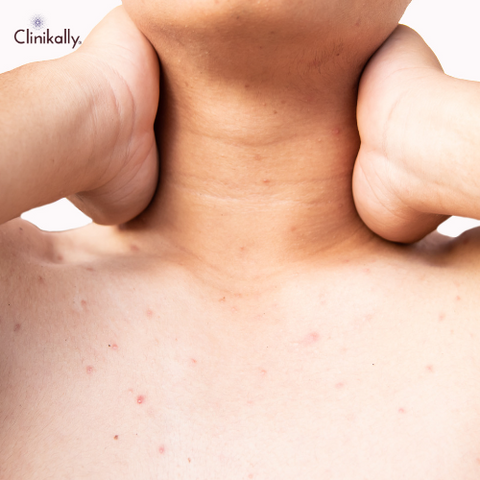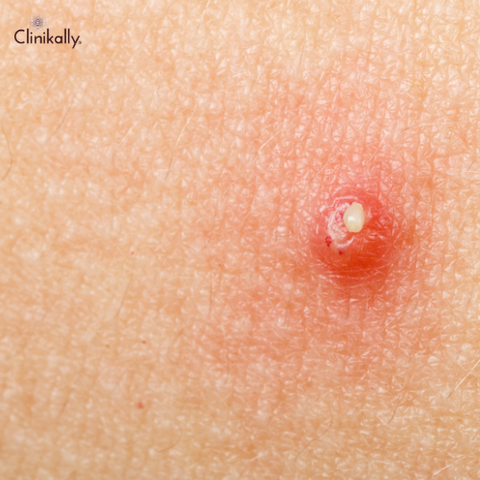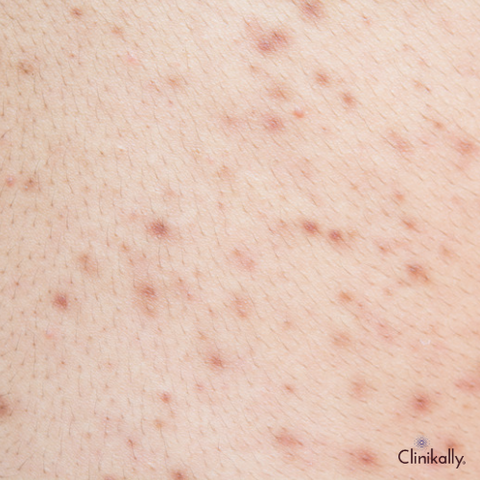Chest acne is a common skin condition that can affect people of all ages. It is also known as chest pimples or acne. It happens when oil, dead skin cells, and bacteria clog the hair follicles on the chest, resulting in red, inflamed pimples. I'll go over the causes, treatments, and prevention of chest acne in this response. Chest acne is a skin condition that is commonly caused by hormonal changes, genetics, sweating, certain medications, and poor hygiene. Treatment options include over-the-counter and prescription topical treatments, oral medications, and chemical peels or laser treatments. Practice good hygiene, use non-comedogenic products, avoid picking or squeezing pimples, manage stress, and consult with a dermatologist if necessary.
Understanding Chest Acne

Acne is a skin condition that nearly everyone will encounter at some point in their lives. It is caused by a build-up of dead skin cells in your pores, which leads to an overabundance of a type of bacteria on your skin called Propionibacterium acne. As a result, your skin becomes inflamed, causing whiteheads, blackheads, or pimples to form. Unfortunately, acne knows no bounds. It is more common in teenagers, but it can affect people of any age, and men and women are roughly equally affected. Acne can also appear anywhere on your body that has oil glands, such as your back, face, stomach, or chest.
What causes chest acne?
The same factors that cause acne on other parts of the body cause chest acne, also known as chest pimples or acne. Acne occurs when hair follicles become clogged with oil, dead skin cells, and bacteria. This can cause pimples, blackheads, and whiteheads to form. The following are the primary causes of chest acne:
-
Hormonal changes: Fluctuations in hormone levels, particularly during puberty, can cause an increase in sebum production, which can clog pores and lead to acne.
-
Genetics: Some people may have a genetic predisposition to acne, making them more likely to develop chest acne.
-
Sweating: Sweat can cause bacteria and dead skin cells to accumulate on the chest, leading to acne.
-
Certain medications: Some medications, such as steroids or lithium, can cause acne as a side effect.
-
Poor hygiene: Not washing the chest regularly or wearing tight clothing can trap bacteria and oil, leading to acne.
-
Friction: Friction from tight clothing or backpack straps can irritate the skin and contribute to the formation of acne.
How to identify chest acne?
The appearance of pimples, blackheads, and whiteheads on the chest area makes it relatively easy to identify chest acne. The following are some of the most common signs and symptoms of chest acne:
-
Red or inflamed pimples: Chest acne often appears as red or inflamed pimples on the chest. These pimples can be painful and may become filled with pus.
-
Blackheads: Blackheads are small, dark spots that appear on the skin's surface. Chest acne can lead to the formation of blackheads, which can be seen on the chest.
-
Whiteheads: Whiteheads are small, white bumps that appear on the skin's surface. Chest acne can cause the formation of whiteheads on the chest.
-
Scarring: In severe cases, chest acne can cause scarring on the chest area.
-
Itching: Chest acne may be accompanied by itching and discomfort.
If you have any of these symptoms on your chest, you most likely have chest acne. It is best to see a dermatologist for a proper diagnosis and treatment plan, especially if the condition is severe or persistent.
Difference between chest acne and regular acne
Chest acne and regular acne are very similar in that both are caused by the clogging of hair follicles with oil, dead skin cells, and bacteria. There are, however, a few key distinctions between chest acne and regular acne:
-
Location: Chest acne occurs specifically on the chest, while regular acne can occur on the face, back, shoulders, and other areas of the body.
-
Skin type: The skin on the chest is thicker and less sensitive than the skin on the face, making chest acne less severe than regular acne.
-
Hormonal influences: When compared to chest acne, hormonal changes, particularly during puberty, can play a larger role in the development of regular acne.
-
Treatment: Treatment for chest acne and regular acne varies depending on the severity of the condition and the underlying causes. However, the treatment options for chest acne are similar to those for regular acne.
Chest Acne Treatments

There are several treatment options for chest acne, including:
-
Topical treatments: Over-the-counter creams, lotions, and gels containing benzoyl peroxide, salicylic acid, or alpha-hydroxy acids can help to unclog pores and reduce inflammation.
-
Prescription medications: In cases of moderate to severe chest acne, a dermatologist may prescribe topical or oral medications such as retinoids, antibiotics, or hormonal therapies.
-
Chemical peels: Chemical peels use an acid solution to exfoliate the skin and unclog pores. This treatment can be effective for reducing the appearance of chest acne.
-
Light therapy: Certain types of light therapy, such as blue light or red light therapy, can help to kill acne-causing bacteria and reduce inflammation.
-
Lifestyle changes: Making lifestyle changes such as wearing loose-fitting clothing, showering after exercise, and avoiding oily or greasy foods can help to prevent chest acne.
The efficacy of these treatments varies depending on the severity and underlying causes of chest acne. A dermatologist can help you determine the best treatment plan for your particular condition. It is also critical to be patient because significant improvement in chest acne can take weeks or months.
Over-the-counter treatments for chest acne
There are several over-the-counter (OTC) treatments available for treating mild to moderate cases of chest acne. These are some examples:
-
Benzoyl peroxide: This is a topical treatment that is available in creams, gels, and lotions. Benzoyl peroxide works by killing acne-causing bacteria, reducing inflammation, and unclogging pores.
-
Salicylic acid: Salicylic acid is a common ingredient in many OTC acne treatments. It works by exfoliating the skin and unclogging pores.
-
Alpha-hydroxy acids: Alpha-hydroxy acids (AHAs) such as glycolic acid and lactic acid are used in many OTC acne treatments. They work by exfoliating the skin and removing dead skin cells, which can help to prevent clogged pores.
-
Sulphur: Sulphur is an ingredient found in some OTC acne treatments. It works by reducing oil production and killing bacteria.
-
Tea tree oil: Tea tree oil is a natural ingredient that has antibacterial properties. It can be found in some OTC acne treatments and can be effective in reducing inflammation and killing bacteria.
It is important to follow the instructions on the product label and use these treatments as directed. It may take several weeks or months of consistent use before you see results, so be patient and persistent with your treatment. If your chest acne does not improve with over-the-counter treatments, you should see a dermatologist for further evaluation and treatment options.
Prescription medications for chest acne
Prescription medications are frequently prescribed for moderate to severe cases of chest acne and may include:
-
Topical retinoids: Topical retinoids such as tretinoin, adapalene, and tazarotene are commonly used to treat acne. They work by reducing inflammation, unclogging pores, and promoting cell turnover. These medications are only available by prescription.
-
Topical antibiotics: Topical antibiotics such as clindamycin and erythromycin can help to reduce the growth of acne-causing bacteria. They are often prescribed in combination with other acne medications.
-
Oral antibiotics: Oral antibiotics such as tetracycline, doxycycline, and minocycline may be prescribed for moderate to severe cases of chest acne. They work by reducing inflammation and killing bacteria.
-
Hormonal therapies: For women with chest acne related to hormonal imbalances, hormonal therapies such as oral contraceptives or spironolactone may be recommended. These medications work by regulating hormone levels and reducing acne.
-
Isotretinoin: Isotretinoin, also known as Accutane, is a powerful oral medication that is used to treat severe cases of acne. It works by reducing oil production, unclogging pores, and reducing inflammation. However, isotretinoin is associated with several potential side effects and is only prescribed for severe cases of acne that have not responded to other treatments.
When using prescription medications for chest acne, it is critical to follow your dermatologist's instructions because they can have side effects and may interact with other medications you are taking.
Natural remedies for chest acne
There are a few natural remedies that may help reduce chest acne:
-
Tea tree oil: Tea tree oil has natural antibacterial properties and can be applied topically to the skin to reduce inflammation and kill acne-causing bacteria.
-
Aloe vera: Aloe vera gel can help to soothe inflamed skin and reduce redness and irritation.
-
Apple cider vinegar: Apple cider vinegar can be used as a natural toner to help balance the skin's pH levels and reduce the growth of bacteria. It should be diluted with water before applying it to the skin.
-
Honey: Honey has natural antibacterial properties and can be applied topically to the skin to reduce inflammation and prevent infection.
-
Green tea: Drinking green tea or applying it topically to the skin may help to reduce inflammation and kill acne-causing bacteria.
While natural remedies can help reduce chest acne, they should never be used instead of medical treatment, especially in moderate to severe cases. A dermatologist should be consulted for an accurate diagnosis and treatment plan. Furthermore, some natural remedies may cause irritation or allergic reactions in some people, so performing a patch test on a small area of skin before using them on a larger area is advised.
Preventing Chest Acne

You can help prevent chest acne by taking the following steps:
-
Keep the skin clean: Wash your chest regularly with a mild, fragrance-free cleanser. Rinse thoroughly to remove all traces of soap before patting the skin dry with a clean towel.
-
Avoid wearing clothing that is too tight: Tight-fitting clothing can cause breakouts by trapping sweat and bacteria against the skin. Choose loose, breathable clothing made of natural fibers like cotton.
-
Avoid irritating fabrics: Synthetic fabrics such as polyester and nylon can irritate the skin and contribute to acne. Choose natural fibers like cotton, linen, and silk.
-
Avoid harsh chemicals: Harsh chemicals such as perfumes, dyes, and fabric softeners can irritate the skin and contribute to acne. Stick to fragrance-free, hypoallergenic products whenever possible.
-
Moisturize: To keep the skin hydrated without clogging pores, use a non-comedogenic moisturizer.
-
Exfoliate: Regular exfoliation can help remove dead skin cells and prevent clogged pores. Use a gentle exfoliating scrub or brush once or twice a week.
-
Be mindful of sun exposure: Exposure to the sun can cause the skin to produce more oil, leading to breakouts. Use a non-comedogenic sunscreen with SPF 30 or higher when spending time outdoors.
-
Manage stress: Stress can contribute to acne by increasing oil production and inflammation. Stress-relieving activities such as meditation, yoga, or deep breathing exercises should be practiced.
You can help reduce the likelihood of developing chest acne by following these preventive measures. However, if you do experience breakouts, it is critical to seek treatment to avoid scarring and further skin damage.
Tips for preventing chest acne
Sure, here are some more preventative measures for chest acne:
-
Shower after sweating: If you exercise or sweat profusely, shower or clean your chest as soon as possible. Sweat can clog pores and aggravate acne.
-
Avoid touching or rubbing your chest: Avoid touching or rubbing your chest with your hands. This can transfer bacteria and oil to your skin, causing acne.
-
Use non-comedogenic products: Non-comedogenic products that do not clog pores should be used. Moisturizers, sunscreen, and makeup are all examples of this.
-
Stay hydrated: Drink plenty of water to help flush toxins out of your body and keep your skin hydrated.
-
Eat a healthy diet: A healthy diet that is rich in fruits, vegetables, whole grains, and lean protein can help to promote healthy skin.
-
Don't pick at your acne: Picking at your acne can cause further inflammation and scarring. It is best to leave your acne alone and allow it to heal naturally.
-
Get enough sleep: Sleeping enough can help reduce stress and promote healthy skin.
-
Be gentle with your skin: When washing and drying your chest, be gentle. Harsh scrubbing or rubbing can irritate the skin and contribute to acne.
You can help prevent chest acne and promote healthy, clear skin by following these tips. If you are prone to acne or have a history of acne, it is critical to establish a regular skincare routine and, if necessary, seek treatment from a dermatologist.
Skincare routine for preventing chest acne
Here is a skincare routine that can help prevent chest acne:
-
Wash your chest with a gentle, fragrance-free cleanser twice a day - once in the morning and once at night. Use warm water and a clean washcloth or your hands to gently massage the cleanser into your skin. Rinse thoroughly and pat dry with a clean towel.
-
Use a gentle exfoliating scrub or brush once or twice a week to remove dead skin cells and prevent clogged pores. Avoid using scrubs with harsh particles that can irritate the skin. Instead, opt for products with gentle, round particles.
-
Use a toner with salicylic acid or glycolic acid to help unclog pores and prevent breakouts. Apply the toner to a cotton pad and gently swipe it over your chest.
-
Use a spot treatment with benzoyl peroxide or salicylic acid to target individual pimples. Apply a small amount directly to the pimple and leave it on overnight.
-
Use a non-comedogenic moisturizer to keep your skin hydrated without clogging pores. Apply a small amount to your chest after cleansing and toning.
-
Apply a non-comedogenic sunscreen with SPF 30 or higher before going outside, especially if you intend to be outside for an extended period of time.
It's important to remember that everyone's skin is different, and what works for one person may not work for another. If you have sensitive skin or are prone to acne, you should develop a skincare routine that is specific to your skin type and concerns. You may want to consult with a dermatologist to get personalized advice on the best skincare products and routines for you.
Lifestyle changes to prevent chest acne
Here are some lifestyle changes that can aid in the prevention of chest acne:
-
Wear loose clothing: Tight clothing can trap sweat and oil against your skin, causing acne. Wear loose-fitting, breathable clothing, especially if the weather is hot and humid..
-
Avoid harsh chemicals: Avoid using harsh chemicals on your skin, such as detergents, fabric softeners, and harsh soaps. These can irritate the skin and contribute to acne. Use fragrance-free, hypoallergenic products instead.
-
Manage stress: Stress can trigger acne by increasing cortisol levels, which can lead to increased oil production. Practice stress-reducing activities like meditation, yoga, or deep breathing exercises.
-
Get enough sleep: Lack of sleep can increase stress levels and contribute to acne. Aim for 7-8 hours of sleep per night.
-
Exercise regularly: Regular exercise can help to reduce stress and improve blood circulation, which can promote healthy skin.
-
Maintain a healthy diet: A healthy diet that is rich in fruits, vegetables, whole grains, and lean protein can help to promote healthy skin. Avoid eating sugary or greasy foods, which can contribute to acne.
-
Stay hydrated: Drinking plenty of water can help to flush toxins out of your body and keep your skin hydrated.
You can help prevent chest acne and promote healthy, clear skin by making these lifestyle changes. If you are prone to acne or have a history of acne, it is critical to establish a regular skincare routine and, if necessary, seek treatment from a dermatologist.








































